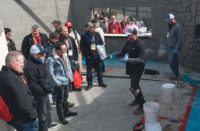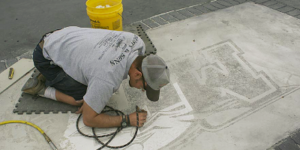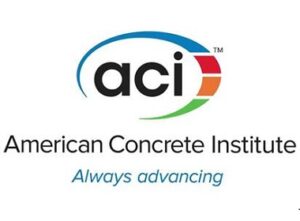
Is training still relevant in the decorative concrete industry? Has the industry reached the maturity stage in its life cycle which directly impacts the desire or need to be trained? Or are we on a plateau, about to witness yet another surge of growth with new technologies and methods?
Training and education have been part of decorative concrete as long as decorative concrete has been around. For the most part, training and education practices have remained the same in our industry over the last 15 years. Is that part of the problem?
It may make me sound old to say this, but I remember when 100+ people would happily give up a day to watch someone stamp and stain a 10-by-10-foot concrete pad. Today, the class sizes are smaller, hundreds have become a dozen (if you’re lucky), and the “same old” does not generate much excitement. So why the decline?
Jim Peterson, a strong proponent of education and founder of ConcreteNetwork.com, a leading online decorative concrete services and information resource, feels there is a direct connection between the decline in attendance at training events and the consumer. “If there was more buyer demand, people [installers] would add more services and more would get in the business, which would lead to more training.”
So why is there a decline in consumer demand? I believe in some areas the industry has become lazy and stagnant. Faster and easier does not always mean better. Decorative concrete is not the “new” product it was 15 years ago.
Innovation is imperative
If you’re an installer, when was the last time you offered a new finish or service? I totally understand the need for consistency and quality, but not at the expense of losing the creative edge. Over the years, the shine has worn off the penny and our market matured from a hot trend to being one of many hardscape options competing for the consumer’s dollar. Add in increased external and internal competition, and the market shrank, as did the number of qualified installers.
So how does this circle back to education? The decorative industry must continue to develop new and innovative products that generate excitement aimed at the consumer and designer. Installers must continue to expand their horizons and push the envelope, while manufacturers must develop products that meet and exceed the consumer and design communities’ needs.
These new ideas and concepts are then shared through proven and new methods of training and education. This will create excitement, which will keep our industry relevant, driving growth at the consumer level.
Training means hands on
Along with excitement and energy created by new products and systems, how the training is presented plays a big part if anyone shows up. Bob Harris, senior decorative concrete consultant for Structural Services Inc., is an industry leader and early vanguard of industry training. He coined a phrase that I think says it all: “It takes years to become an overnight success.”
Bob, and his wife, Lee Ann (who shies away from the spotlight but is also a wealth of knowledge), are two of the most passionate and outspoken advocates for education and training in the decorative industry. Bob is a true craftsman with an eye for detail, as his work clearly demonstrates. His philosophy regarding quality and detail carries over into his training sessions.
“We have always preached that students need to focus on one or two topics and become very proficient at these applications before moving on to other market segments,” he says. He walked me through what a typical stamped concrete class at his facility looks like.
“Operating a Bobcat, shooting elevations, setting forms and placing upwards of 20 cubic yards of both patterned and seamless stamp,” he rattles off. “We also cover making repairs and sealing the next day.”
It is the philosophy of “quality over quantity,” which is at the heart of decorative concrete when you think about it. This also sheds light on the difference between a “demo,” where products are demonstrated, and a “training” where the intent is to have those attending be hands-on and involved. Over the years, attending a training has become a day off. If you are taking the time to attend, take advantage of what’s being presented and get involved!
Behind the Trowels
Interestingly, the new trend with training appears to be less about content and more about how the content is shared. “www.BehindtheTrowels.com” is a new online training program created by Keefe Duhon and Wess Robison. Robison says the decorative industry needs to catch up to the digital age when it comes to training. “Behind the Trowels is intended to put affordable, professional and relevant training at the fingertips of installers from across the world,” he says.
The duo offers one-hour live online sessions on specific installations, systems or industry trends. Paying subscribers can interact with the presenter, ask questions and share ideas, versus watching a prerecorded video, which, Robison says, “separates us from the digital world.”
Both he and Duhon are strong advocates for education, no matter the form it takes. They say online training already exists in the medical, legal, oil and educational industries, and they feel it’s a great fit for the decorative concrete industry. They are also upfront admitting that there is no substitution for quality hands-on instructor-led training. Their concept fills a void for those unable to attend a class or feel more comfortable using the online format.
“We are excited to offer another medium of training — one that is affordable, does not require travel expenses and time away from work,” Robison says. They went live in late September with their first online class that showed a metallic epoxy application in a bathroom shower. They are busy scheduling new topics for future classes.

Engage in education
I realize how precious time is, and when a contractor isn’t working he’s not getting paid. I also know the value of education as one of the most critical factors in the health of our industry. There is little excitement when the headline is the same day after day, or the content never changes.
Decorative concrete, as an industry, is fighting an uphill battle when you consider our largest producers and installers are small compared to the corporations that produce pavers and other competitive hardscape materials. When was the last time you saw a full-page ad in a high-end national home and garden magazine promoting stamped concrete? Concrete pavers and composite decking are front and center every month.
But we have something those other products don’t — flexibility and installer creativity. At the end of the day you can do things with decorative concrete that pavers, wood, tile and composites can’t touch.
Artistic creativity and a continuous flow of new ideas have been an integral part of why decorative concrete is where it is today. Without training and the exchange of ideas, a big part of that growth never occurs. This is bigger than just one person or one company.
It’s important all of us who make a living in decorative concrete support and engage in education. As Robison with Behind The Trowel put it, “Whether participating in instructor-led training, online training or networking, learning should never stop!”















